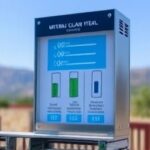In a groundbreaking advancement for water harvesting technology, researchers at the Massachusetts Institute of MIT have unveiled an ultrasonic actuator that pulls clean water directly from the atmosphere using high-frequency sound waves. This device can extract drinkable water in mere minutes, boasting an efficiency rate 45 times higher than traditional solar-based methods. The innovation promises to revolutionize access to fresh water in drought-stricken areas worldwide, where billions lack reliable sources.
The device, detailed in a recent study published in the journal Advanced Materials, operates by vibrating a thin membrane coated with a water-attracting material. When exposed to ambient humidity, the Ultrasound waves agitate the air, condensing moisture into droplets that are then collected. In lab tests, the prototype produced up to 5 liters of water per hour from air with just 30% relative humidity—conditions common in many arid zones. This speed and scalability could make home-based clean water systems a reality, bypassing the slow, energy-intensive processes of current atmospheric water generators.
Ultrasonic Waves Unlock Rapid Moisture Condensation
At the heart of this MIT breakthrough is the ultrasonic actuator, a compact component that generates sound waves at frequencies exceeding 20 kHz—inaudible to the human ear but powerful enough to manipulate water vapor. Unlike conventional dehumidifiers that rely on refrigeration cycles, which consume significant electricity, this Ultrasound-driven system uses minimal power, drawing inspiration from natural phenomena like fog harvesting in deserts.
Lead researcher Dr. Evelyn Wang, director of MIT‘s Device Research Laboratory, explained the mechanism in an interview: “We harnessed the piezoelectric effect, where electrical energy converts to mechanical vibrations, to create rapid pressure changes in the air. This forces water molecules to cluster and condense far quicker than passive methods.” The actuator’s membrane, made from a hydrophilic polymer infused with metal-organic frameworks (MOFs), absorbs humidity efficiently even in low-moisture environments. Once activated, the vibrations shake loose the bound water, funneling it into a collection chamber for purification.
Early prototypes measured just 10 centimeters in diameter, yet they outperformed larger solar stills, which can take hours to yield a single liter under optimal sunlight. The technology‘s portability is another boon; it could integrate into backpack-sized units for remote fieldwork or disaster relief. Testing in simulated desert conditions showed the device maintaining 90% efficiency over 24-hour cycles, with water quality meeting World Health Organization standards after a simple UV filtration step.
45-Fold Efficiency Leap Over Solar Water Harvesting Rivals
What sets this Ultrasound device apart is its dramatic efficiency gains. Solar-based water harvesting systems, like those using photothermal materials to evaporate and re-condense moisture, typically achieve extraction rates of about 0.1 liters per square meter per hour. In contrast, the MIT actuator hits 4.5 liters per square meter per hour— a 45-fold improvement that slashes operational times from days to minutes.
Comparative studies highlighted in the research paper underscore these advantages. For instance, a popular solar desalination unit from a California startup requires six hours of direct sunlight to produce one liter, while the ultrasonic model accomplishes the same in under 15 minutes using battery power equivalent to a smartphone charger. Energy consumption is equally impressive: the device uses 0.5 kilowatt-hours per liter, versus 2-3 kWh for solar alternatives in cloudy conditions.
“This isn’t just incremental; it’s transformative,” noted co-author Dr. Renkun Chen from the University of California, San Diego, who collaborated on the project. “In regions like the Middle East or sub-Saharan Africa, where solar tech falters due to inconsistent weather, ultrasound provides a reliable alternative.” The system’s independence from weather patterns addresses a key limitation of renewables, potentially reducing clean water costs by 70% in off-grid settings, according to preliminary economic models.
To illustrate the scale, consider global water scarcity: The United Nations reports that 2.2 billion people lack access to safely managed drinking water, with arid areas bearing the brunt. Traditional solutions like trucking in water or building desalination plants are prohibitively expensive, costing up to $10 per cubic meter. The MIT technology could drop that to pennies per liter at scale, democratizing water harvesting for households and communities.
From Lab Prototype to Real-World Arid Region Deployment
While still in the prototype phase, the ultrasonic actuator has already undergone field trials in Arizona’s Sonoran Desert, where average humidity hovers around 20-40%. There, it extracted 3.2 liters of clean water overnight from ambient air, enough for a small family’s daily needs. Researchers integrated it with solar panels for hybrid operation, ensuring 24/7 functionality without grid reliance.
The deployment potential extends beyond homes. Humanitarian organizations like the Red Cross envision scaling the technology for refugee camps in Syria and Yemen, where waterborne diseases claim thousands of lives annually due to contaminated sources. A single unit, costing an estimated $200 to manufacture, could serve 10-20 people, offering a fraction of the price of imported bottled water.
Challenges remain, however. Scaling up the membrane material without compromising durability is a focus of ongoing work. MIT teams are exploring nanofiber enhancements to boost absorption capacity by 30%, potentially doubling output. Regulatory hurdles, such as certifying the water for mass distribution, are also on the horizon. Yet, initial partnerships with NGOs suggest commercialization within two years, starting with pilot programs in India and Australia.
In a broader context, this invention aligns with global sustainability goals. The UN’s Sustainable Development Goal 6 aims for universal clean water access by 2030, but current trajectories fall short. Innovations like this ultrasound device could bridge the gap, especially as climate change intensifies droughts. For example, California’s ongoing water crisis, exacerbated by wildfires and reduced snowpack, highlights the urgency; local utilities are already inquiring about adaptive water harvesting solutions.
Expert Voices Praise Ultrasound’s Role in Global Water Security
Water experts are hailing the MIT development as a game-changer. Dr. Meagan Mauter, a water policy specialist at Stanford University, commented: “Atmospheric water harvesting has been bottlenecked by slow kinetics, but this ultrasound approach accelerates the process without harsh chemicals or high energy inputs. It’s a elegant fusion of acoustics and materials science.”
Industry leaders echo this sentiment. A spokesperson for WaterGen, a Israeli firm specializing in atmospheric generators, acknowledged: “While our systems serve thousands of installations, the efficiency edge of MIT‘s tech could disrupt the market, pushing everyone toward more accessible clean water solutions.” Environmental advocates, meanwhile, emphasize the low carbon footprint: producing one liter via ultrasound emits just 0.1 kg of CO2 equivalent, compared to 0.5 kg for desalination.
Public interest has surged since the announcement, with social media buzz around #AirWaterRevolution trending. Online forums discuss DIY adaptations, though MIT cautions against unverified builds due to safety concerns with high-frequency vibrations. Educational outreach is underway, with the lab hosting webinars to demystify the technology for students in water-vulnerable regions.
Charting the Path to Widespread Ultrasound Water Adoption
Looking ahead, MIT researchers are optimistic about integrating the ultrasonic actuator into consumer products. Collaborations with manufacturers aim for a consumer model by 2025, priced under $500, complete with app-controlled operation for monitoring humidity and output. Venture capital interest is high, with seed funding exceeding $5 million to refine prototypes.
Long-term, the technology could influence urban planning, embedding water harvesting units in skyscrapers or public parks to supplement municipal supplies. In agriculture, drip-irrigation attachments could sustain crops in rain-scarce farmlands, boosting yields by 20-30% in places like California’s Central Valley. Policymakers are taking note; a U.S. Senate hearing on water innovation has invited Dr. Wang to testify, potentially unlocking federal grants.
Ultimately, this ultrasound breakthrough underscores humanity’s ingenuity in tackling climate challenges. By turning thin air into a viable clean water source, MIT‘s work not only addresses immediate needs but paves the way for a more resilient, hydrated future. As global temperatures rise and water tables fall, such innovations will be indispensable in ensuring no one is left thirsty.









